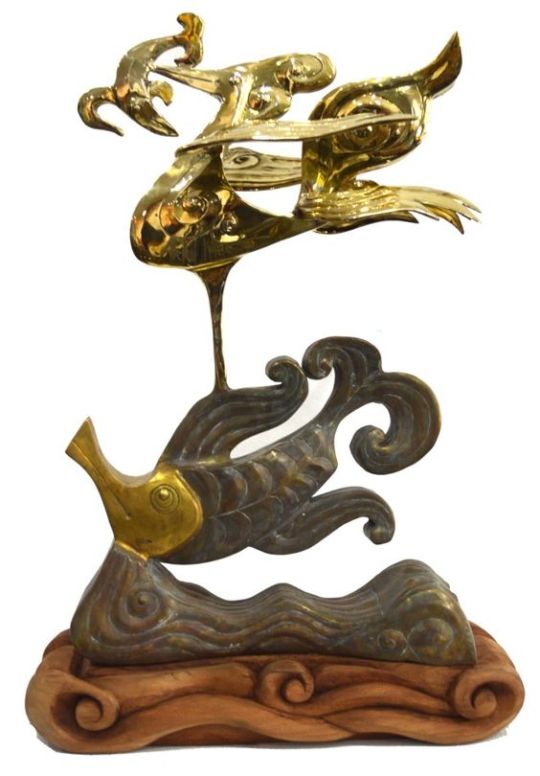#Abdulmari Imao
Text

ABDULMARI ASIA IMAO
Sariisda, akriliko sa kambas, 2012
#artPH
#abdulmari asia imao#sariisda#sarifish#larawang-pinta#painting#akriliko sa kambas#acrylic on canvas#sining biswal#visual arts#filipino art#artPH
2 notes
·
View notes
Text
Works of National Artists Abdulmari Imao, Federico Aguilar Alcuaz to be NFTs Soon on Artifract
Subscribe to our newsletter!
Editing by Nathaniel Cajuday
Through the partnership signed last year by Artifract and the heirs of Abdulmari Imao and Federico Aguilar Alcuaz, the artworks of the National Artists will soon be accessible on Artifract.io as NFTs.
According to Imao’s son, Toym, the soon-to-launch NFTs will feature the Sarimanok motif of the older Imao which is re-imagined into the…

View On WordPress
0 notes
Text
Understanding an overlooked past
Understanding an overlooked past
Theater Review
Anak Datu
Presented by Tanghalang Pilipino
IN 1968, long before he was named a National Artist for Visual Arts, Abdulmari Imao wrote a short story called “Anak Datu,” about a community in the Sulu archipelago that was invaded by pirates. Over 50 years later, his short story has evolved into a play with music that weaves the story with the experience of the Imao family and the…

View On WordPress
0 notes
Photo

Abdulmari Asia Imao (1936 - 2014) - Sarimanok. 1997. Acrylic on canvas.
123 notes
·
View notes
Text
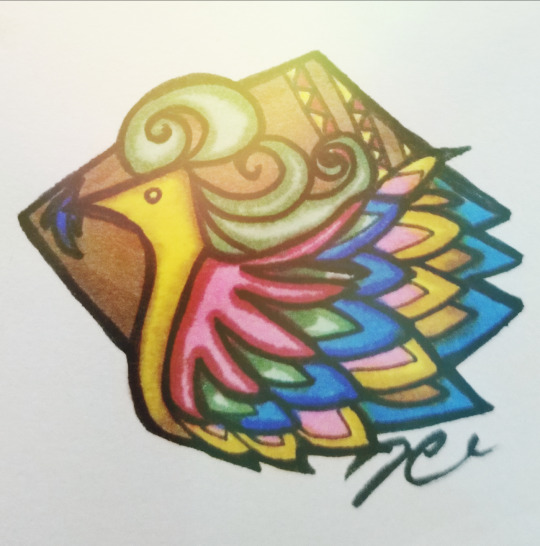
29/365
sarimanok
1 note
·
View note
Text
Art into Culture: Becoming one with Nature
Art is something that has existed throughout the timeline of history of mankind. It showed records of how civilizations and phenomenons have shaped our current lives. In this case, the Philippines is rich in this kind of context wherein there are even works that are debatable and currently under investigation for further research.
Philippines is home to different kinds of beliefs particularly Philippine Mythology. Each region has its own kind, as each deities resemble something in nature--an honor to the oldest religion of the country which was “animism”. They became a part of fad lately in the field of Philippine art, amateur artists and art students posting their works about them online starting from digital art, to the traditional one which is from sketch, or even in themes in literature (an inspiration for other Asian works that once a fad turning into a trend) that was inspired by the rise of historical genre in the country.
A great example in this field is Mr. Abdulmari Asia Imao, one of the National Artist in the country. He is deeply anchored in his tradition, an exemplar Filipino artist and should be an inspiration to all creative Filipinos, particularly those engaged in cultural work. He also stated that because of his deep roots, he was able to give our art a very much distinct and very much needed Filipino face that we really needed in our generation today especially when it comes to a form of art. The use of Sarimanok as a motif for some of his artworks helped popularize the creature. With his knowledge about culture and with his own experience, he created an artwork where it promotes the connection of Filipino-muslim art. And with this creation, he made the Filipino culture bloom and be developed. He made the filipino art more competitive and more interesting as he was able to promote and made a move for the filipino art to be known worldwide. He made it more ineteresting by putting his consciousness into it and made it meaningful.

(One of the Sarimanok painting of Imao)
He had definitely promoted the values of community, service, and work. Upon seeing his works, not only this is to express his own ideas about his culture, he has shown the main essence of it particularly the Sarimanok- nature. It is a form of calling in which we must have an insight of what we have ever since, The effect of westernization has great impacted most of us, making us lose the identity of who we are and the events that lead to the present.
Another example for this is one of the works of the members, a watercolor artwork by Jerilyn Cruz. She expressed that nature is not just simply about the literally green environment, but it can also be a human nature wise.
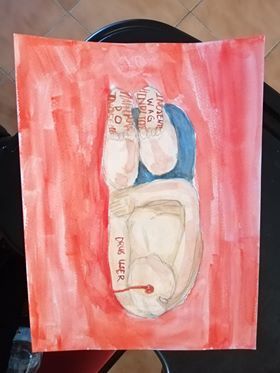
(photo and artwork by Jerilyn Cruz)
“Nature more than just the environment. Nature could also be human nature- connecting towards your identity. The Sarimanok is a mythological creature that came from Mindanao, so it can be said that the Sarimanok is deeply ingrained in the identity of Maranao. It became a symbolism for multiple things. Community stems from a human being social beings, naturally enjoying the company and looking for a companion. With this, being in a community is part of human nature. Appreciating art is also within the human nature-the preference for beauty and being drawn toward aesthetics. My artwork clashes with the rich artwork of the Sarimanok. My artwork depicts the community’s suffering under the past years. The killings and self-righteousness of bad men have plagued the country. This can be a parallel towards expressing beauty and the good things. The artwork expresses sadness and hope for the current times, in the community. - Jerilyn Cruz”
The final point of this is that, nature is a part of culture as stated from the title itself. It is a part of the identity that builds up who we are today, hence making us value and treasure each resources that we are still having as of today, for it may fade once we decided to leave it behind or forget to leave it in the past.
Blog Editor: Karoline De Jesus
Writers: Felise Alibudbud, Jerilyn Cruz, Karoline De Jesus, Dwight Lade
Assistant Writers: Fiona Miranda
Photos: Jerilyn Cruz
Meet the Staff: Felise Alibudbud, Jerilyn Cruz, Karoline De Jesus, Dwight Lade, Fiona Miranda, Mikko Sarmiento, Jonel Zamora
BAIS 1A
3 notes
·
View notes
Text
MORO ARTIST, NAGPINTA PARA SA KAPAYAPAAN
MORO ARTIST, NAGPINTA PARA SA KAPAYAPAAN
SA pamamagitan ng canvass, isinulong ng Tausug painter na si Rameer Amilasan Tawasil ang kapayapaan. Ito ay isang drawing inspiration mula sa madilim niyang pagkabata na dinungisan ng patayan at labanan ng Moro rebellion.
Sa kanyang mga obra, ginagamitan ito ni Tawasil ng malalim na pag-iisip upang maipalaganap ang kasunduan sa Mindanao.
(more…)
View On WordPress
0 notes
Photo
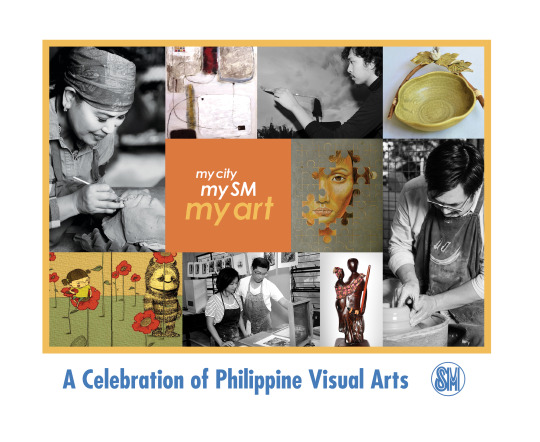
Bringing Art and People Together
ABOUT MY CITY, MY SM, MY ART
My City, My SM, My Art, which recently launched its book just in time for the National Arts Month, is the latest edition in the My City, My SM series, which celebrates the beauty, culture, traditions, and great people in cities around the Philippines where SM has malls.
This comes after My City, My SM, which promotes tourism; My City, My SM, My Cuisine, which highlights heirloom recipes from prominent families in the different regions; and My City, My SM, My Crafts, which showcases traditional arts and modern Philippine design.
My City, My SM, My Art celebrates Philippine visual arts – painting, sculpture, printmaking, photography, and filmmaking. It aims to bring people and art together in a roadshow featuring the works of masters, modernists, and millennials around the SM Supermalls.
Our cultural journey began on March 2016 at SM Seaside City in Cebu with an exhibit featuring artists from the Queen City of the South including maestro Romulo Galicano; and concluded on March 2019 at SM City Cebu with the masterpieces of Manuel Rodriguez, Sr., the Father of Philippine Printmaking leading the way.
In between, our search for art and artists brought us as far north as the Baguio and the Cordilleras and as far south as General Santos in Mindanao. During those three years, we advocated art for all by working closely with communities, schools, and the public to mount exhibits, workshops, and contests in key cities around the Philippines. These were featured in the Philippine Star, our project partner, as well as in local media, and a cultural series in regional cable channels.
To make all these possible, we collaborated with the National Commission for Culture and the Arts, the Metropolitan Museum of Manila, and the Shell Companies of the Philippines; as well as the Philippine Star, Center Stage Productions, and Finale Art File.
Along the way, we were able to have a glimpse of what makes Philippine art unique, and how close family ties, ingenuity, and a sense of community have played key roles in its development.
We have seen how Filipino art has flourished through families like the Abellanas of Cebu; as well as those of masters Mauro Malang Santos, Jose Pitok Blanco, and Eduardo Castrillo whose children – and in some cases grandchildren – now represent a new generation visual artists. There are also wonderful examples of how art ties fathers and sons together – National Artist Abdulmari Imao and Toym, National Living Treasure Eduardo Mutuc and Eduardo, Jr., Ricarte Puruganan and Victor, Manuel Baldemor and Monnar, Romulo Olazo and Jonathan.
Family members have also played significant roles in preserving the artistic legacies of their loved ones: Josie Baldovino for her brother National Artist Jose Joya, Daisy Tolentino-Mendez for her father National Artist Guillermo Tolentino, and Totong Francisco II for his grandfather National Artist Carlos Botong Francisco. We were both honored and touched when the family of Manuel Rodriguez, Sr. flew all the way from the US and the Bahamas to join us in the tribute to their father at SM City Cebu.
We were also amazed at how Filipino artists created groundbreaking works from non-traditional materials. With art supplies either too costly or simply unavailable, Baguio’s Jordan Mang-osan and Patric Palasi found their niche in solar and coffee art, respectively; while Palawan’s Elordie Mesac crafted his pieces from rubber slippers. When his materials were washed away by super-typhoon Yolanda, Tacloban-born Dante Enage began using tuba, a local wine made from coconut juice, as his medium.
The rise of regional Fine Arts schools like the Philippine High School for the Arts in Laguna, the University of Mindanao, the University of Rizal System, La Consolacion College in Bacolod, Ateneo de Naga, and the Adventist University of the Philippines in Cavite have likewise been vital to the growth of the arts around the country.
We also saw how art thrived when artists got together in collectives like the Tam-Awan Village in Baguio, the Artist’s Village in Baler, and Pinto Art Museum in Rizal.
Now, after three years, more than 30 stops, hundreds of artworks, and a myriad of memorable experiences, we have compiled our exciting cultural journey in a book. Join us as we unravel the exquisite tapestry of Philippine art through the lives and works of some of the country’s most fascinating visual artists.
Join in our cultural adventure at our microsite https://mystorymysm.com/mycitymysmmyart/ and our YouTube Channel at https://www.youtube.com/mycitymysmmyart. Please also watch out for our television series over at Converge San Pablo and Royal Cable Community Channel.
0 notes
Photo

Isang mapagpalayang araw sa lahat! #Mabuhay ang #Pilipinas! Happy 122th #IndependenceDay #Philippines! I was playing around with this amazing #typeface based on #Nationalartist Abdulmari Asia #Imao's #Sarimanok motif. #obratypeface #kalayaan #kalayaan2020 #mananita #makibaka #makibakawagmatakot (at Pasay City, Philippines) https://www.instagram.com/p/CBUWI48hvaS/?igshid=ka59ofhoh2qf
#mabuhay#pilipinas#independenceday#philippines#typeface#nationalartist#imao#sarimanok#obratypeface#kalayaan#kalayaan2020#mananita#makibaka#makibakawagmatakot
1 note
·
View note
Text
THE FIRST FONT NAMED AFTER A FILIPINO IS HERE

The Philippines is oozing with widely-acclaimed, iconic artworks. But ask almost anyone on the street, and they’ll struggle to name the artists behind many obra maestras.
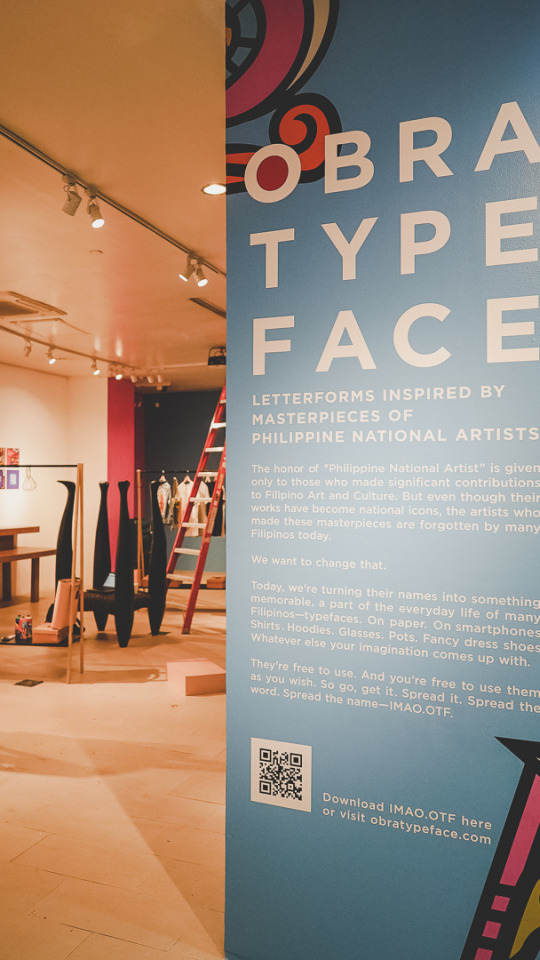
Enter Obra Typeface, an initiative by J. Walter Thompson Philippines and Ayala Museum, which aims to familiarize Filipinos with National Artists by using something everyone is familiar with—typefaces.
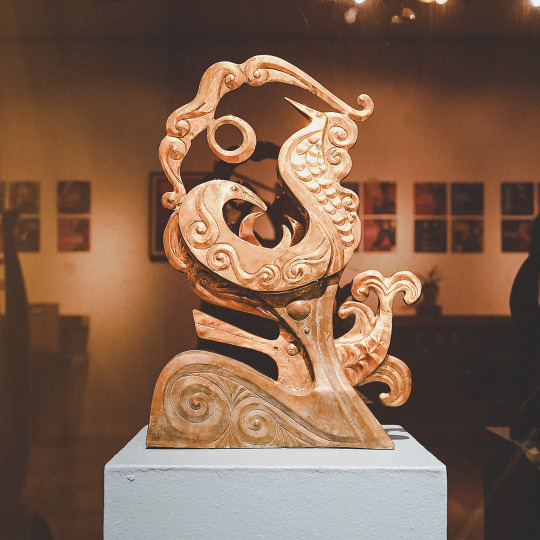
As its first foray, the team crafted a display type, the Imao Obra Typeface or Imao.otf, inspired by the works of National Artist Abdulmari Asia Imao. The project was launched on May 6, 2019 with an exhibition dedicated to the Imao Obra Typeface at the Ayala Museum.
A native of Sulu, Abdulmari Asia Imao made his mark in Philippine art through his use of Tausug and Maranao motifs. He was awarded the honor of Philippine National Artist in 2006. Imao’s trademark icons—the sarimanok, okir, and naga motifs - were integrated into every typeface character, creating a rich tapestry of letters and images.
The aim of combining the artworks and the artist’s name into the typeface is to make it easier for people to remember the person behind the masterpieces.
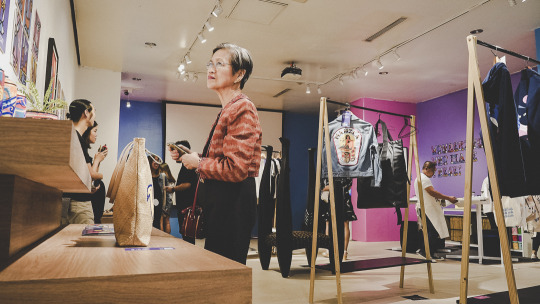
Part of the exhibition is a special showcase of everyday items designed with the Imao Obra Typeface. Artists and designers were tasked to translate the typefaces into merchandise such as shirts, jackets, hats, shoes, bags, and even home items like pots, lamps, spray can centerpieces, and a chair. Collaborators in this project include Abre Linea, Aranaz, Artwork, Boyet Custodio, Drin Alejandro, Femi Cachola, Fine Time Studios, Geoff Estevez, Jappy Agoncillo, Joco Comendador, Kenneth Tan, Pako.ph, Renan Pacson, Support Your Friends, Wanderskye and Drea Dizon, Leeroy New, Ibarra Watches, and WSH.

A merger of different art forms, united together by a singular typeface. One inspired by an artist who aimed to unite Filipinos of all creeds and culture.
The Imao Obra Typeface exhibition is free to the public and will be on view until May 30, 2019 at the 2F of the Ayala Museum. The Imao Obra Typeface or the Imao.OTF is free to use and free to download online at www.obratypeface.com
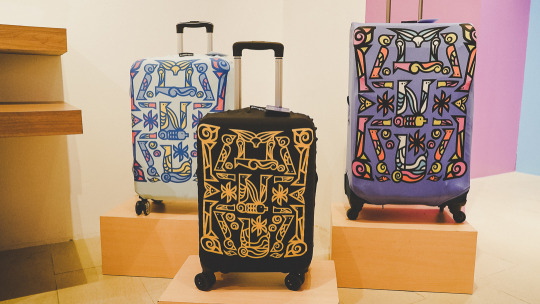
0 notes
Text
CHED continues Fulbright scholarship for Filipino faculty members
#PHnews: CHED continues Fulbright scholarship for Filipino faculty members
MANILA – The Commission on Higher Education (CHED) and the Embassy of the United States of America signed on Monday a new CHED-Fulbright agreement to implement a scholarship program to send Filipino higher education institution personnel abroad to pursue graduate degree and non-degree thesis/dissertation programs in American universities.
US Ambassador to Philippines Sung Kim and CHED chairman J. Prospero de Vera III signed the new CHED-Fulbright agreement to boost student and faculty mobility in various fields of study and facilitate alternating missions to the Philippines and United States for higher education executives and stakeholders.
The Fulbright program which was founded by United States Senator J. William Fulbright in 1946, is one of the most widely recognized and prestigious scholarships in the world. It has produced luminaries such as former Senator Rene Saguisag, former Supreme Court Chief Justice and Senate President Marcelo Fernan, National Artists Bienvenido Lumbera, Napoleon Abueva, Abdulmari Asia Imao, and Lucrecia Kasilag, and National Scientist and former CHED head Angel Alcala.
De Vera was a Fulbright Hays Scholar at the University of Southern California and a Senior Fulbright Visiting Fellow at the Johns Hopkins University.
Many current and former Presidents of state universities and colleges (SUCs) such as Dr. Shirley Agrupis (Mariano Marcos State University), Dr. Lourdes Generalao (University of Southeastern Philippines, Dr. Anthony Penaso (Caraga State University), Dr. Joy Sorrosa (Davao del Norte State College) and Dr. Herbert Reyes (Northwestern Mindanao State College of Science and Technology) are also products of the program.
Since 1948, PAEF has awarded Fulbright grants to nearly 3,000 Filipinos and close to 1,000 Americans to study, teach, lecture, and conduct research in the United States and the Philippines.
“CHED through Commission en Banc Resolution No. 501-2016 approved the partnership between the CHED and the Philippine-American Educational Foundation. We are giving PHP164 million for the next batch of scholars,” de Vera said.
In Nov. 2, 2016, CHED and PAEF awarded its first batch of Fulbright-CHED Scholarship grantees for the September 2017 Intake, which was composed of 17 competent and highly qualified Filipino higher education faculty and staff who would pursue their graduate studies in the United States. The 17 scholars pursued a Master’s degree (7 scholars), nine pursued a Doctorate degree, and one pursued a Doctoral Dissertation Research in different American universities.
A total of 19 Fulbright-CHED scholars were sent for graduate studies in the US in September 2018 (9 PhDs, 6 MAs, and 3 Non-degree grantees).
The scholarship provides funding support for tuition and fees, non-academic fees, monthly allowance, airfare, excess baggage, in-transit allowance, dissertation, and other academic support, which is equivalent to USD77,250 or PHP3.9 million (conversion based on the date of signing) for two years.
“Currently, we have 18 scholars (11 from batch 1 and 7 from batch 2) who have already completed their program and are expected to render return service to their respective sending higher education institutions,” de Vera said.
“The Fulbright program has produced so many outstanding leaders in the academe, industry and in government. This new agreement continues this valuable and mutually beneficial partnership between the two countries,” he added.
The signing ceremony was held at the Fulbright Head Office in Greenfield Tower, Mandaluyong City and was also attended by the representatives from the US Embassy: Public Affairs Officer Philip Roskamp, Cultural Affairs Officer Matt Keener and Cultural Affairs Specialist Christine Grace Catindig; representatives from Fulbright Philippines: Executive Director Julio Amador III and Program and Communications Officer Joanne Fajardo and; CHED OIC Deputy Executive Director and International Affairs Staff Director Lily Freida Milla. (CHED PR)
***
References:
* Philippine News Agency. "CHED continues Fulbright scholarship for Filipino faculty members." Philippine News Agency. https://www.pna.gov.ph/articles/1113291 (accessed August 25, 2020 at 09:55PM UTC+14).
* Philippine News Agency. "CHED continues Fulbright scholarship for Filipino faculty members." Archive Today. https://archive.ph/?run=1&url=https://www.pna.gov.ph/articles/1113291 (archived).
0 notes
Text

National Artist Dr. Abdulmari Asia Imao
with his paintings and sculptures of Sarimanok
0 notes
Photo

ABDULMARI ASIA IMAO
Abdulmari Imao
the first Muslim recipient of the Philippine National Artist Award – a sculptor and painter who fused traditional Islamic design with Modernist patterns to result in vivid works that yearn for local color and the dream of a unified nation, died peacefully in his sleep last December 16 at his house in Marikina City. He was 78 years old. Known for his unique adaptation of traditional Muslim Mindanaon motifs, such as the ukkil (sinuous relief woodcarving tradition found in houses and boats), the naga (sea serpent motif ), pako rabong (fern motif ), and sarimanok (mythical bird-with-fish figure), Mari, as he was called by friends and family, persevered to unite an innate sense to continue the carving and painting traditions of his Tausug forebears with a more Modern sensibility that created abstracted patterns for sculpture and painting that combines these motifs with Cubism. In addition, Mari was one of few Muslim-Filipino artists who would work on the figurative genre in sculpture, which is often discouraged because of the Koranic strictures against the representation of human figures.
Mari persevered to unite an innate sense to continue the carving and painting traditions of his Tausug forebears with a more modern sensibility the created abstracted patterns for sculpture and painting the combines these motifs with Cubism.
SARIBONG
He calls these combined compositions the saribong, meaning the fusion of the sarimanok, pako rabong, and Islamic motifs such as the dome and crescent moon. He has also utilized the human figure as a public monumental element in his various sculptures dedicated to local heroes and historical figures, such as “President Elpidio Quirino” in Manila. His more recent mystical treatment of Islamic motifs, particularly in the calligraphic sculptural works called the Allah series starting in 1985, has also brought Abdulmari full circle back his Muslim roots. Abdulmari Asia Imao is survived by four sons from his marriage with Grace de Leon Imao (who also passed away in 2012): Abdulmari Junior, nicknamed Toym; Jose Mari or Joey; Juan Sajid; and Alkarim or Kim. Toym (who took up Architecture) and Sajid (who took up Studio Arts) are both sculptors, while Joey, an accomplished painter himself, is a US-based dentist, and Kim is an interior design and lifestyle specialist. In addition, Toym is also a filmmaker and actor.
SARIMANOK
A triumphant force emanates this sculpture of a sarimanok—the mythical brass bird appears like a shining trophy atop the wooden fish. Though employed in two vastly different mediums, both figures are united in their intricate carvings that emphasize the creature’s lush, fluid curves. Exhibiting distinct qualities that merited him to be the first Muslim National Artist, the work is testament to how Imao effortlessly fuses Mindanaon motifs, modern mediums and forms, and the victorious Filipino spirit into one.
0 notes
Text
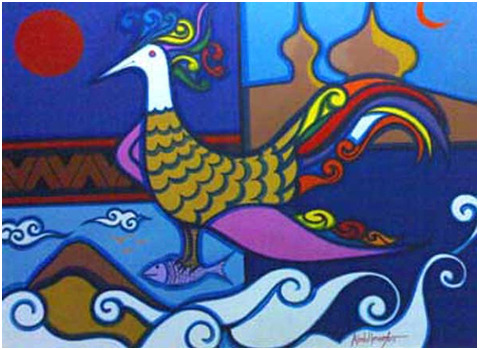
Sarimanok ng Bayan ng Mapayapa by National Artist Abdulmari Asia Imao in front of the Vargas Museum
“Sarimanok ng Bayan na Mapayapa” is an art piece made by National Artist Award for Visual Arts recipient Abdulmari Asia Imao. This art piece has an oil paint in a canvas as the type of media used for the creation. This art piece had been created during the year 2006. It stands as a 36 inches by 48 inches artwork.
The artwork shows an image of a sarimanok, which is considered to be a legendary bird of the Maranao people who originate from Mindanao. Its name has been derived from the words “sari” which means garment or clothing and “manok” which means chicken. The sarimanok shown in the artwork is a complete image of the said legendary animal and has been placed in the middle of the whole of the artwork. Also, the sarimanok stands out among the other objects shown in the artwork as it is the largest thing that a viewer can see in the painting. In the background, it shows an image of a circle on the left side while a crescent on the right side along with two buildings with a dome as the roof. The said objects can be considered as some of the Islamic symbols considering the artist, Abdulmari Asia Imao’s background. He is a muslim originating in Sulu he himself said that he has been focusing on the sarimanok style, improving it and revitalizing it to develop it into another design that will become distinctively muslim.
The art piece has been consisting of mostly curves. It is minimal when it comes to straight lines. In the main subject of the art piece, the sarimanok, it is made up of mostly curves with only its beak that contains straight lines. The feathers, the tails, and the hair are shaped with curved lines. Making it appear flowing. These scroll-like, leafy and spiral motifs are considered to be the symbols of good fortune. With art piece focusing on the sarimanok, it is likely that the dominance of curved lines in the piece as a whole would be a connection to the legendary animal.
The colors present in the artwork are various. As it is a legendary animal derived from the clothes of the Maranao tribe, the animal also contains a variety of color in its feathers to represent the colorful garments of the said tribe. When it comes to size, the sarimanok dominates the space in the artwork. It appears to be the largest object. This alone would represent its characteristic in the Islamic legend as an enormous animal where its crest has touched the second heaven though it is only in the first heaven among the seven heavens that the legend believed to have which is also further fortified by the shape resembling a mountain beneath its talons. The background has a single dominant color which blue though in two different shades which is in stark contrast to the animal. The animal has various colors that do not seem to have followed a common color scheme. However, despite this, the clashing of the colors creates a harmonious effect which really sets the animal apart from its background.
In terms of light, the artwork seems to have a contrast. The background has been divided into two parts vertically. The left side has a dark blue color above and a light blue color below while the other side has a light blue color on top of a dark blue color. This difference probably represents the two heavens in which the sarimanok is believed to have touched. Additionally, the left side has a round shape while the right side has a crescent shape which could represent sun and moon respectively which contributes to the contrast.
The artwork also contains shapes that resemble clouds. The shapes seem to contain movement and let the viewer think that it is moving to the left. This is also reinforced by the sarimanok and the fish in its talons as both are facing to the left.
Overall, the artwork represents the Islamic culture and belief with an emphasis on the legendary animal, “sarimanok”. I find the artwork interesting and striking. It changed my perception of colors and how it should be complementary to each other. As I look at the artwork, it emanates a positive vibe especially when I see the thin line between the sarimanok’s beaks which makes the animal appear to be smiling which I think is what the artist would want to say knowing that the artist’s objective is to promote his religion’s culture and belief.

Allah Calligraphy by National Artist Abdulmari Asia Imao in front of the Vargas Museum
One artwork of Abdulmari Imao is his painting entitled, “Allah Calligraphy”. This painting is showcased during the Eidl Fitr in Newport Mall in Pasay City in the gallery entitle, “Unite as Muslim and Christian artist as one” which showcases the paintings of Muslims and Christian showing family values and traditions here in the Philippines. This gallery show in which many paintings of different artist in the Philippines was held during the 2014. This gallery is one way to show how untied the Filipinos are despite of being divided by different religions by showing a glimpse of what their culture are through the most creative way a man could ever do, their artworks.
The painting shows or portray Islamic culture which is evident by the symbols that is used in the painting just like the star and crescent moon. It somehow shows a mosque that serves as a worship place for our Muslim brothers and sisters. The painting uses dark colors that emphasizes each figure and also uses colors that compliments each other. The painting is composed of lines that makes up different shapes and figures. Such as the blue and green line that connects to make up a roof of the mosque. The painting has no other illustrations and just focuses on one subject matter in the positive space. The way we see the stroke of the paintbrush that the artist has made can make us conclude a smooth texture of his artwork. The way how the colors produced consistency in such a way that it doesn’t change its value for it remains dark color shades. Such as the background, it maintains dark red, the colors blue and green maintans dark, the color yellow in the painting remains dark, all color shades in the painting artwork remains the same. All in all, this artwork of Abdulmari Imao is a magnificent one for it portrays and gives justice to the elements of art accordingly.
Interpretation:
This artwork symbolizes the unity of Muslims during the day of Eid’l Fitr for Allah’s sake after Ramadhan month. Eid’l Fitr is a Muslim festival celebrating the end of the feast of Ramadhan. Ramadhan is very important for our muslim brothers ad sisters for it is one of their act of worship to their God, Allah. At the center of the painting has the name of Allah written in arabic. It represents that our Muslim brothers and sisters do things for Allah and place Allah at the center of it all. For them, if you place Allah at the center of everthing, all things will fall according to its perfect places. The crescent moon in the painting is called the Hilal that is used as symbol together with the star in Islam.

Untitled piece (1984) by National Artist Abdulmari Asia Imao in front of the Vargas Museum
Calligraphic in form, this large-scale piece rests atop a concrete platform. It is the first work to greet museum visitors once they enter the driveway. It cues vision to the museum building and the sprawling ground beside it. This work is example of Philippine modern sculpture that expresses and embodies Muslim ethnic identity through abstract form. As chronicled in Pasyal, a monograph on public art in the university, this brass piece combines three themes from Islamic iconography. One is the 5-pointed star atop the structure reminiscent of the sari-mosque which when can be spotted, it gives an idea to them that it is the crest of the Muslim religion. The core of the sculpture evokes the figure of the sari-manok, a mythical rooster carrying a fish in its beak. The curvilinear shape reminds us of the motifs pako rabong and naga from the Tausug and Maranao woodcarving traditions. It looks great due to its eye catching in line of sight. It has an arrangement of objects or themes which combining the three interrelated themes, that of the sari-mosque as identified in the 5-pointed star that sits within the crescent moon, that of the sari-manok or the rooster with a fish caught in its beak, and that of the sari-okir with its curvilinear motif. There is only one color which is gray that makes it calming to look. It is well carved and polished because some are straight lines, curvy, and formation of the three themes. It’s a public viewing sculpture because of its position and angle as well as the placement. Its abstract form portrays the combination of different shapes and forms which some are not in a fixed shape that makes it more complicated to determine its actual spacing and meaning. In other words it is a subtle in its contrast which the sculpture’s form is difficult to be analyzed or described. Its movement is flowing due to some curvaceous lines and edges. Its color is pale due to its cement-like color that makes it more a cemented sculpture to be seen by. The sculpture is also Asymmetrical because unequal proportioned elements.
The painting makes me feel puzzled due to its abstact form which is hard to figure out what does the sculpture portrays. It is cool due to the color and if the light touches the sculpture, it will more likely to brighten up due to its color to absort light. I believe that he made the sculpture to bring Muslim culture closer to a wider audience in terms of their identity, tradition, and overall in their religion. It is catchy to the eye of the viewers and set as the reason of curiosity towards the viewers of what would be the sculpture wants to tell us. We can also observe that the scale or size of the sculpture is monumental type and i guess the reason why is it monumental it is because the artist of this sculpture wants us to realize how important our culture is, though it looks like old now as you can see on the picture but then the essence of the sculpture remains new specially to us millennials, because it tells us and notice the Muslim ethnic identity through abstract form.
0 notes
Photo
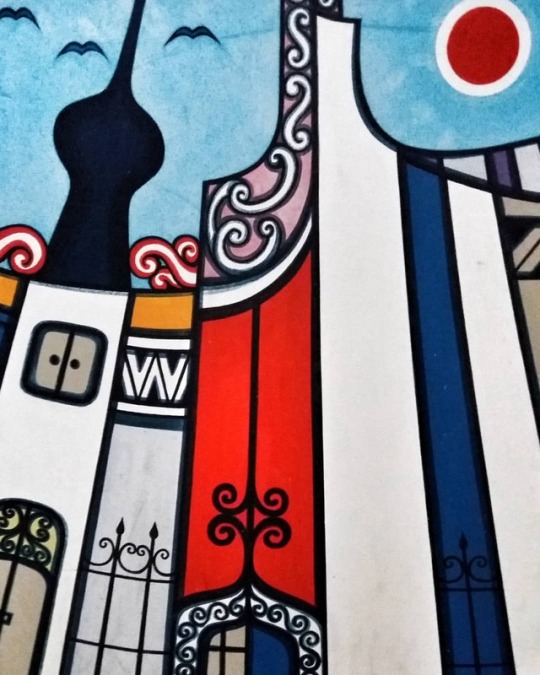
Peace is not the absence of conflict. It is the ability to handle conflict by peaceful means. - Ronald Reagan Artwork: "Mosque" Abdulmari Asia Imao Philippine National Artist for Sculpture and Painting (at Aga Khan Museum)
0 notes
